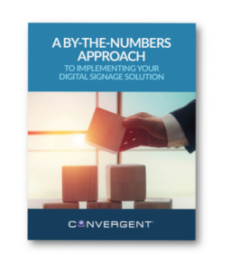
“Design is thinking made visual.” – Graphic designer Saul Bass
Digital signage has its own design discipline. It’s not the same as print, or web, or television. Digital signage design needs to bring focus and context to a brand’s story without some of the usual tricks – such as using sound with video. And it calls for a specific infrastructure for production and delivery unlike that for print, web and video.
As a matter of fact, since it’s dynamic and motion-oriented, digital signage design has more in common with two other fields of design – animation and movie titles – than with those that make little to no use of movement. And because of that, we’ve learned and applied lessons from masters in those fields to make digital signage more engaging – and ultimately create signage that does its job more effectively.
Motion design makes the experience better
Graphic designer and Academy Award winner Saul Bass was best known for his design of movie title sequences and posters. During his 40-year career, he worked for some of Hollywood’s most prominent filmmakers, including Stanley Kubrick, Martin Scorsese and Alfred Hitchcock.
His title designs illustrate the role of graphics and motion in setting the stage for a movie. If you’ve seen Hitchcock’s Vertigo, for example, you’ll remember the whirling graphics that open the film and invoke the disorientation of the main character, played by Jimmy Stewart. The title design establishes the movie’s mood and themes and explains that character’s state of mind without using a word of dialogue to do so.
The point of good motion design is to make the audience’s experience better without watchers even knowing how that was accomplished. Someone familiar with film certainly could articulate why Vertigo’s opening works. But the average viewer will immediately get caught up in the movie without needing to understand anything at all about motion design.
The same is true of digital signage. We use motion design principles to engage people in our signage and its messages. The principles play out on screen in a subtle way that most viewers won’t notice and might not be able to explain, but when used right, they pack a big punch.
Digital signage and Disney princesses
You may not be surprised to learn that many of the motion design principles we use to create digital signage came from the home of Mickey Mouse, Snow White and Peter Pan: The Walt Disney Company.
Two Disney master animators, Ollie Johnston and Frank Thomas, introduced 12 basic principles of animation in their 1981 book, The Illusion of Life: Disney Animation. No matter the style of animation, those principles can be seen in almost any motion-based design, including that for digital signage.
Four of the most important ones — those we employ every day in our work for clients — are:
- Staging (or what we call hierarchy). This refers to the order in which elements appear on the screen and the prominence that they’re given. It creates focus for viewers and helps them understand the story you’re telling.
In this example, we use the composition of the screen and our ability to span messages over time to bring order and logic to the message, making it easier to grasp and remember.
- Timing (or pacing). Timing is about how fast or slow the elements of signage move and what that contributes to your message and its emotion and readability.
We use a good slow pace to bring the products onto the screen just long enough to understand the visual and then introduce the message in such a way that there is proper read time, but at a pace that makes the whole message make sense.
- Slow in and slow out (or easing). Think about the distance it takes for a car to start and then stop moving. It begins slowly, accelerates and then slows down before it stops. Using this technique in digital signage means content moves in and out smoothly, not abruptly, which appears more natural to the eye. (This, by the way, is the reason why PowerPoint animations look amateur; watch them the next time around with this principle in mind.)
This is an exaggerated example of headphones spinning, but shows how slowing or speeding up a movement makes it more impactful and interesting.
- Arcs (or natural movement). Due to the action of gravity, rarely does anything alive move in a perfectly straight line, including the human body. As with easing content on and off a screen, mimicking that natural movement in signage elements also is more pleasing to viewers.
Watch how the ball bounces and moves. Without the natural attention to movement, it would look unrealistic, but as we add arcs to the move, it gives the ball weight and dimension.
In this final example, these and many other principles are used to create a memorable impression in the viewer. Sometimes the principles are more exaggerated and other times less noticeable, but overall, if you compare two messages – the first one , which ignores the principles and the second one, which utilizes them – the difference make a huge impact.
If you’re wondering why your digital signage seems a little awkward, examine it with those four principles in mind. You might find that one, two or all of them need attention. The changes might be subtle; the differences in engagement and the success of your signage won’t be.
If you’re attending the Digital Signage Expo at the end of March and want to learn more about digital signage design, join Adam for his workshop,
.
The post
appeared first on
.
![]()








 “The brain . . . is designed to solve problems related to surviving in an unstable outdoor environment and to do so in nearly constant motion (to keep you alive long enough to pass your genes on). We were not the strongest on the planet, but we developed the strongest brains, the key to our survival,” says this
“The brain . . . is designed to solve problems related to surviving in an unstable outdoor environment and to do so in nearly constant motion (to keep you alive long enough to pass your genes on). We were not the strongest on the planet, but we developed the strongest brains, the key to our survival,” says this 